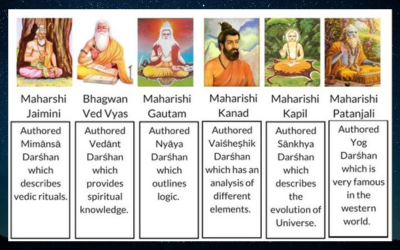Patanjali Yog Sutras is the theme of Swami Mukundananda’s 2024 Life Transformation Program in many US cities. These discourses enable participants to better understand the science of Yog or the union of the mind with God from the masters of the science of mind management – Maharshi Patanjali and Swamiji.
The Patanjali Yog Sutras are revered as foundational in the practice of Yog. Comprising 196 aphorisms, these sutras encapsulate the essence of the eight limbs of Yog (i.e., Ashtanga Yog). These are related to the nature of the mind (i.e., Chitta) and the stages of meditation (i.e., Dhyan). offering practical insights that can be applied in our daily lives to cultivate inner peace, harmony, and spiritual elevation.
The story of how Maharshi Patanjali inscribed the vast divine knowledge into short sutras or aphorisms is interesting in and of itself! Let us explore the historical underpinnings of this remarkable scripture.
Patanjali Yog Sutras: Historical Context
The historical context suggests that human beings on earth were overwhelmed by the physical, mental, intellectual, and spiritual sorrows presented by Maya Devi. They went to Lord Vishnu in Kshirsagar where He was lying on the divine Naag, Anant Shesh. They appealed to the Lord that people in the world continued to be inflicted with all types of diseases despite his descent. They pleaded for His benevolence to relieve the suffering souls.
Anant Shesh also heard their pleas for help and his heart was filled with compassion as well. So, Lord Vishnu comforted them and told them not to worry. He convinced them that Anant Shesh or Shesh Naag would take an avatar to teach people the knowledge of the science of relief from worldly miseries.
A short time after this incident, another interesting incident took place. One time, Lord Shiv was doing the Tandav dance. Lord Vishnu became so engrossed in the rhythmic moves that He too started swaying from side to side while lying on Anant Shesh. Anant Shesh was very impressed with how Lord Vishnu was experiencing deep pleasure. He too wanted to become a dancer to please his master.
These two events became the impetus for the avatar of Anant Shesh. Subsequently, one time a scholarly lady by the name of Gonika was feeling very sad that even though she possessed the theoretical and practical knowledge of the scriptures, there was no one to whom to pass on the divine knowledge. She did not have a child. One day when she was offering “Anjali” to Lord Vishnu with her palms joined and facing upward, a tiny baby serpent fell into her palms. Within minutes, it grew and took on the form of a human being. He later came to be known as Patanjali – Pat (पत) meaning the one who fell, and Anjali (अंजलि) meaning the offering of the holy water to God. Anant Shesh took an avatar as Patanjali (पतंजलि).
Patanjali’s scholarly knowledge is beyond compare, which is not surprising because he was the avatar of Shree Balaram (Shree Krishna’s older brother) and Shree Lakshman (Lord Ram’s younger brother). The primary purpose of his avatar was to present the divine knowledge in his Yog darshan. These Yog sutras fall in the category of Smritis.
Maharshi Patanjali, a reputed scholar of the Yogic system and Sanskrit, wrote the most popular Yog Darshan, which is a part of the Shad Darshan (i.e., six philosophical thesis). Six sages (see image below) inscribed these works to help people understand and implement the knowledge of the Vedic scriptures in their daily lives.

Maharshi Patanjali’s Yog Darshan comprises four Pads or chapters, i.e., Samadhi Pad, Sadhana Pad, Vibhuti Pad, and Kaivalya Pad written in short aphorisms that string together deep philosophy in a few words in each verse. This blog presents powerful gems related to the functioning of the mind and intellect, necessary for mind management.
Patanjali’s Gems for Mind Management
Gem #1: Negative Thoughts Waste Our Energy. We must always strive to maintain positive thoughts and assess the quality of our thoughts to reap the benefits. Thoughts can be evaluated by the feelings they evoke, for example, beneficial thoughts will uplift us and generate bliss. Awareness of the type of thoughts can then lead to constructive actions. The key to reversing negative thoughts is to practice the reverse thought.
Gem #2: Obstacles in the Path of Spirituality. Obstacles in the path of spirituality include disease, mental inertia, doubt, carelessness, laziness, absence of detachment, fallacious perception, lack of perseverance, and unsteadiness in concentration. One must always aim to overcome these obstacles. A few examples are practicing meditation to remove mental diseases, applying intellectual prowess to get rid of mental inertia, and developing a hunger for God to eradicate any doubts.
Gem #3: Ingredients to Success in Devotion. There are five key ingredients needed to succeed in devotion. These include faith, energy, memory, focus, and intelligence.
- Faith: Faith is necessary for devotion. Faith must be based on divine knowledge of the scriptures and developed intelligently to complete this journey. Faith that is not based on true knowledge tends to be blind and will lead to doubt.
- Energy: We must pursue the path of devotion energetically. When we tread this path with an increased speed, all the seemingly insurmountable obstacles will become insignificant.
- Memory: Spiritual growth involves new lessons and insights learned from a variety of experiences. A good memory serves to remember the key learnings to be able to draw upon them when needed. This is the recipe for success.
- Focus: When we make God the primary focus of our life, all priorities align accordingly. The goal is to attain Yog with God, which can happen only when the mind is focused exclusively on God. The mind must attach to God without wasting it on anything worldly.
- Intelligence: We must ensure that all efforts to attain the desired goal are made with intelligent choices. This does not mean that we apply our material intellect to comprehend God’s and Guru’s plans or logic. It means that we must intelligently accept the teachings of God, the scriptures, and the Guru.
Gem #4: Practice Detachment. The states of the mind are influenced by different factors. On the spiritual journey, one must endeavor to control the mind through detachment and practice. Detachment from worldly pleasures is a slow process. There are four stages in this process.
- Examination and Analysis. First, a devotee examines and analyzes situations for true happiness. Do material objects truly give me happiness when compared to spiritual activities?
- Discrimination: Second, the devotee discriminates life situations as harmful (e.g., Preya pleasures) or helpful (Shreya pleasures) and chooses wise actions accordingly. The realization that we are the soul and material pleasures will not provide long-term eternal happiness is a critical aspect of discrimination.
- Joyful peace: Third, as worldly detachment increases, the mind also cleanses and people experience bliss. This leads to joyful peace.
- Intellectually Guided Absorption. Lastly one reaches a stage where the mind stays absorbed in God driven by the intellect. In the initial stages, detachment is based on the power of the intellect but at the ultimate stage of God-realization, it is based on the natural experience of bliss. This is the most inspirational piece of this gem.
Gem #5: Learn Mind Management. On the spiritual journey, one must learn to control the mind. Controlling the mind is extremely difficult because it is made of the material energy, Maya. It is more difficult to control the mind than the wind (Bhagavad Gita 6.34). Detachment and practice are the sovereign keys to control the mind. With continued effort and deliberate practice, one will be successful.
Gem #6: Always Remember God. Memory is a treasured gift of God. Short-term and long-term memories are two aspects of memory. To remember anything long-term, one must use repetition to create permanent neural connections in the brain, which can be accessed when needed. The deeper the connection, the deeper the memory. Simply remembering God by remembering His name will always change the state of mind and move it in the right direction. We will then gradually move ahead in the right direction toward God-realization.
Gem #7: Improve the Quality of the Mind. Spiritual aspirants must endeavor to improve the quality or functioning of the mind. The cause of bondage and liberation is the mind (Bhagavad Gita 4.33). Whatever form of devotion we do, we must engage our minds in meditating upon God. If the mind is attached to the world, then the external aspects of renunciation will not lead to any spiritual progress. We experience both pleasure and pain with the mind. Maharshi Patanjali advises us to not suppress the mind’s desires but to redirect them toward God.
Improving the quality of the mind is important but beyond the mind is the intellect; beyond the intellect is the ego, and beyond it is the soul. The mind has three functional states: mind (mana), intelligence (buddhi), and ego (ahankar) and it can be purified only by surrendering all three states to God. However, we human beings identify with our bodies because of a stream of thoughts that pervade the mind. If we learn to identify with the soul, then the thoughts that pervade the mind will be pure, allowing us to perceive our soul and identify with it.
Swamiji’s Life Transformation Program in Dallas

To learn more about how to utilize the power of thoughts to control the mind based on Maharshi Patanjali’s Yog Sutras, we invite you to participate in JKYog’s Life Transformation Program in Dallas to immerse yourself in spiritual upliftment with fellow devotees. Join us for the most enlightening discourses by Swamiji for an entire week. Register for the program now!
Dates: August 3 to 9, 2024, 7:00 to 9:00 PM
Location: Radha Krishna Temple of Dallas, 1450 N Watters Rd, Allen TX 75013



